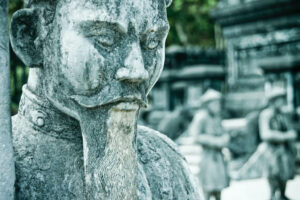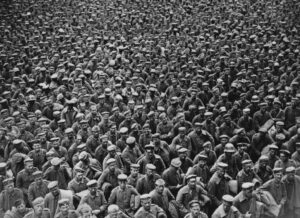In the dimly lit trenches of World War I, where every move could mean life…
The Origins of Oktoberfest
- by Mamparra

As the curtain of fall descends upon us, a familiar set of seasonal events graces the world: the crisp embrace of autumn air, eerie tales of ghosts and ghouls, the breathtaking transformation of leaves into vibrant hues, and the eagerly anticipated celebration known as Oktoberfest. This Bavarian tradition has carved its place in the hearts of people around the globe, characterized by lively and exuberant festivities that encompass dance, the iconic lederhosen attire, delectable sausages, and, of course, an abundance of beer.
Yet, in the midst of the revelry, how often do we pause to ponder the historical roots of Oktoberfest or question the ubiquity of those sometimes “hideous” lederhosen? In this in-depth exploration, we embark on a journey through time to unearth the captivating origins of Oktoberfest and the intricate web of history that intertwines with this annual spectacle.
The Royal Celebration
The story of Oktoberfest finds its genesis in the grandeur of a royal wedding—the union of Crown Prince Ludwig of Bavaria and Princess Therese von Sachsen-Hildburghausen. This opulent matrimonial affair unfolded on October 12, 1810, in the city of Munich, Bavaria. Eager to share their joy with the commoners, the couple, along with their royal parents, orchestrated a lavish wedding festivity accessible to all Munich residents. The chosen venue? A sprawling pastureland just beyond the ancient walls of the city.
As the day dawned, approximately forty thousand Bavarian residents converged to partake in this historic celebration. And partake they did! The festivities were marked by unbridled feasting, copious libations, and spirited dancing. The celebrations reached a zenith with the thundering hooves of racing horses, as the Prince and his bride likely cheered on the competing stallions, their pockets potentially bulging with sizable bets. The picturesque field that hosted this splendid event was christened “Theresienwiese,” signifying “Therese’s fields,” in honor of the radiant bride. In modern vernacular, it is succinctly referred to as “Wiesn,” an abbreviation of the original name. This sacred ground now serves as the annual venue for Munich’s Oktoberfest.
The subsequent year, in 1811, the Bavarian monarchs chose to extend the festivities, introducing additional horse races and an agricultural fair. Recognizing the immense popularity of these events, they continued the celebration in 1812, and thus commenced a tradition that has endured for over two centuries. Despite a few exceptional cancellations resulting from extenuating circumstances such as disease or war, Oktoberfest stands as a cherished and timeless tradition. Officially, the festival commemorates the marriage of Prince Ludwig and Princess Therese, who would later ascend to the throne as King Ludwig and Queen Therese of Bavaria in 1825.
However, Oktoberfest represents more than just a celebration of a royal union; it is also a tribute to the artistry of beer-making. Interestingly, the marriage itself was not without its challenges, making the festival’s origins all the more intriguing.
A Voyage Through Brewing History
To grasp the profound connection between Oktoberfest and beer, we must embark on a journey through the annals of brewing history. Beer, one of the world’s oldest alcoholic beverages, boasts a lineage that stretches back thousands of years.
Approximately nine thousand years ago, in ancient China, people embarked on the practice of concocting a fermented drink by mixing rice, honey, and fermented fruit—a beverage recognized today as the earliest intentionally mixed alcoholic concoction. Nevertheless, it was in ancient Mesopotamia, around 5,000 years ago, that barley beer emerged as the predominant form of this intoxicating elixir. Most closely associated with the Middle East and the Sumerians, barley beer weaves a rich historical tapestry. In 1992, local researchers serendipitously stumbled upon ceramics bearing beer-like residue, with these artifacts believed to date back to approximately 3500 BCE. The “Hymn of Ninkasi,” an ode to the Sumerian goddess of beer, not only venerates her but also includes a recipe for ancient beer dating back 3,800 years—though the actual method is likely even older.
From the cradle of Mesopotamia, the art of brewing beer embarked on a global odyssey, leading to regional variations in formulas and styles. Historical records affirm that both the Egyptians and Romans savored beer alongside their other libations. Intriguingly, in regions such as England and Germany, where cold weather thwarted grape cultivation and vineyard management, beer reigned supreme. In these lands, wine, the prominent alcoholic beverage of the era, was a rarity.
As the tradition of brewing continued to evolve, one transformative development emerged—the introduction of hops. This fragrant flower not only contributed to beer’s preservation but also enhanced its flavor. Hops made their entry during the Middle Ages, leading to the diverse array of beer styles recognized today.
Interestingly, the type of beer produced often hinged on the season and prevailing weather conditions. Brewers concocted top-fermented beers, including ales, stouts, porters, and wheat beers, during the warmer months. These beers involved fermenting the brew at temperatures ranging from 62 to 77 degrees Fahrenheit, causing the yeast to rise to the top. This process engendered the creation of ales, to which hops were added to perfect the flavor profile.
In contrast, bottom-fermentation, responsible for lagers, pilsners, bocks, and even American malt liquor, occurred during the winter months. This method inadvertently came to light in the 16th century when beer was stored in cool, dry caverns at temperatures of 46 degrees Fahrenheit or lower for extended periods. As a result, the brewing of specific beer varieties became contingent on the prevailing season and climatic conditions.

Deep in the heart of the Andes Mountains, along the shores of Lake Titicaca in…

In the late 15th century, Amerigo Vespucci embarked on voyages to the New World, distinct…
A Celebration of Beer and Tradition
Against this rich backdrop of brewing history, we can truly appreciate Oktoberfest’s dual significance. The festival not only commemorates a royal wedding but also pays homage to the centuries-old tradition of brewing beer. Oktoberfest stands as a testament to the enduring appeal of beer and the joyous celebration of life’s pleasures.
So, the next time you raise a stein of frothy beer at Oktoberfest, take a moment to revel not only in the festivities but also in the deep-rooted history and traditions that have converged to create this iconic celebration. Prost to the rich legacy of Oktoberfest and the art of brewing that continues to unite people in merriment!
As the curtain of fall descends upon us, a familiar set of seasonal events graces the world: the crisp embrace of autumn air, eerie tales of ghosts and ghouls, the breathtaking transformation of leaves into vibrant hues, and the eagerly anticipated celebration known as Oktoberfest. This Bavarian tradition has carved its place in the hearts…
Recent Mamparras
- Zwai Bala – The Musical Pioneer Who Helped Shape South Africa’s Sound
- Is This the Worst Own Goal Ever? Watch and Decide
- Mamparras Spend R7.7 Billion From 25th to the 31st of December 2024
- Why Do Liberals Think Trump Supporters Are Mamparas?
- Indepth Look at the Online Thrill to Grill Casino Game
- Artist Discovers 2000yo Roman Bust at Texas Goodwill for $34
- Nobuntu (Mamparra-nobs) Mkhize Disrupts FlySafair Flight – Gets Arrested
- Oscar Pistorius Walks Free, But Where is Reeva’s Justice?
- The Accidental Aboriginal’s Legacy
- The Origins of Oktoberfest
- Fascinating Quick Facts

